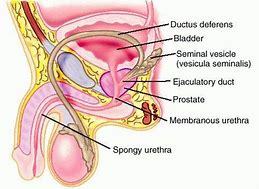Seminal Vesiculitis: Causes, Symptoms, Diagnosis and Treatments
Date:2020-09-28 click:0
Seminal vesiculitis and prostatitis often occur at the same time, and it is caused by a retrograde infection in most of the cases. It is generally divided into acute and chronic types, and the key pathogenic bacteria are Staphylococcus aureus, hemolytic streptococcus, and Escherichia coli.

Causes
There are three main ways of infection of seminal vesiculitis.
1. Upward infection
This condition often occurs when bacteria spread to the seminal vesicle through the urethra and ejaculatory duct.
2. Lymphatic infection
The inflammation of the urogenital tract or intestines can infect seminal vesicles through the lymph.
3. Blood infection
In other parts of the body, when the pathogen of an infected focus circulates to the seminal vesicle through blood, because there are many mucosal folds and twists in the seminal vesicle anatomy, the secretion is easy to deposit, leading to poor drainage. If the acute inflammation is not completely treated, it is easy to develop into chronic seminal vesiculitis.
Symptoms
Seminal vesiculitis is one of the most common infectious diseases in men, and the age of onset is mostly 20-40 years old. The main clinical manifestations are hematospermia, but there are acute and chronic differences, individual differences, clinical manifestations are different.
1. Pain
In acute cases, lower abdominal pain can occur, involving perineum and bilateral groins. Chronic patients may have suprapubic pain and perineum discomfort, and the symptoms of pain increased significantly during ejaculation.
2. Frequency, urgency and pain of urination
In acute cases, the symptoms of urgency and pain are obvious, and dysuria occurs. In chronic cases, the increased frequency and urgency of urination were obvious, accompanied by discomfort of urination and burning sensation.
3. Blood in semen
The semen is pink or red or with blood clots, and the condition is more obvious in acute cases.
4. Other symptoms
Patients may also have fever, chills, which are the systemic symptoms that usually occur in acute cases. Hematuria is also one of the manifestations of acute seminal vesiculitis. Ejaculation pain, low sexual desire, spermatorrhea, and premature ejaculation are common in chronic cases.
Diagnosis
1. Semen analysis
2. Seminal vesicography
3. Ultrasonic inspection
4. CT and MRI scanning
Treatment
The seminal vesicle is not an organ for storing semen, but an accessory gland of the male genitals. It is a pair of long oval saclike organs. It is located at the back of the bladder bottom and the outside of ampulla of vas deferens.
The shape is wide at the top and narrow at the bottom, slightly flat at the front and back, uneven on the surface, free at the upper end, expanded at the bottom of the seminal vesicle, thin and straight at the lower end, which is its discharge pipe.
Due to the structural characteristics of the seminal vesicle, when inflammation occurs, the drainage will be poor, and after the invasion of bacteria, it is difficult to cure completely. In order to prevent seminal vesiculitis from prolonging, it should be treated thoroughly, whether it is acute or chronic.
1. Antibiotics
Select the appropriate antibiotics for acute seminal vesiculitis, and patients should continue to use antibiotics for 1-2 weeks after the symptoms disappear completely. For chronic seminal vesiculitis, we should continue to use antibiotics for more than 4 weeks to consolidate the curative effect.
2. Local treatment of berberine ion penetration
Use 1 ‰ berberine 20ml for enema after relieving yourself, put the gauze pad soaked with this medicine on the perineum, and connect it to the anode of the DC physiotherapy device, and apply the cathode on the pubic bone, 20 minutes each time, once a day, ten days as a course.
Patients can also take a warm sitz bath(water temperature 42 ℃) and perineum hot compress to improve local blood circulation and help inflammation subside. It is advised to avoid sitting too long to prevent pelvic congestion.
3. Traditional Chinese medicine
Herbal medicine Diuretic and Anti-inflammatory Pill can be selected. In the view of traditional Chinese medicine, seminal vesiculitis belongs to the category of the downward flow of damp and heat and stagnation of Qi and blood.
The efficacy of sterilization and detoxification, diuresis and relieving stranguria, activating blood circulation and removing stasis in Diuretic and Anti-inflammatory Pill can play a very good role in treatment. At the same time, the functions of anti-proliferation, anti-fibrosis and anti calcification can eliminate the pathological changes of the diseased tissue, enhance the immune function of the patients, so as to achieve a thorough cure and prevent a recurrence.
Adjuvant therapy
1. Sleeping in bed and taking defecation drugs to keep the bowel movements regular
2. Avoid frequent sex to reduce the degree of congestion of sexual organs. The patients with chronic seminal vesiculitis can be massaged regularly (once or twice a week).
3. Develop a regular lifestyle and avoid smoking, drinking and spicy food.
4. Enhance confidence in curing the disease, do not worry too much.
You may also be interested in:
Seminal Vesiculitis Cured By Traditional Chinese Medicine
Home Remedies for Seminal Vesiculitis
You may also be interested in:
Seminal Vesiculitis Cured By Traditional Chinese Medicine
Home Remedies for Seminal Vesiculitis



